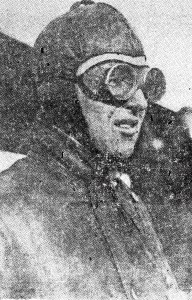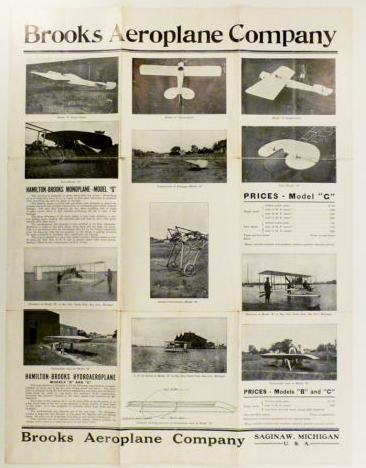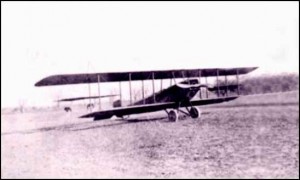“The Birdman” Donald R. McGee
June 5, 2015
Donald R. McGee Memorial Scholarship
 Don “The Birdman” McGee was Saginaw’s first pilot, making the first flight ever over the city on August 21, 1915. He took off from Merrill that morning and 20 minutes after take-off, landed in a field near Gratiot, before resuming his flight that then carried him over the city.
Don “The Birdman” McGee was Saginaw’s first pilot, making the first flight ever over the city on August 21, 1915. He took off from Merrill that morning and 20 minutes after take-off, landed in a field near Gratiot, before resuming his flight that then carried him over the city.
The Saginaw Couier-Herald reported: “on account of his motor being hot and himself rather tired from his exertions, he decided to land before attempting the dangerous flight over Saginaw.”
Thousands left their homes and offices to witness Don’s flight. Until this moment, aviation was something that had only been read about and not seen.
“Steadily and surely, the bird-like machine approached from the west, crossed the river, sailed over Genesee Avenue to Weadock, turned south and proceeded to the Realty company’s grounds at Sheridan and Washington where a landing was made.”
Don was born in Cleveland, Ohio on February 26, 1896. By the time he was eight, he was jumping off barn roofs with an umbrella held over his head. In 1907, Don’s family moved to Saginaw and he graduated from umbrella jumps to constructing gliders.
Don became obsessed with flight, devouring every bit of information he could find regarding aviation. Along with his best friend, Joe Behse, whose father, owner of the Modart Corset factory here in town, possessed one of the few automobiles in Saginaw, conducted glider flying experiments at Hoyt Park. Don and Joe would attach Don’s glider, little more than spruce framework and cotton fabric, to the car. Don and Joe repeated these tests many times and Don never gained a flight of more than a few feet and crashed everytime. Each time he failed, he learned a bit more about why he failed.
 In 1910, there was an airplane manufacturer in Saginaw. The Brooks Boat Company established an airplane division at its site on Jefferson near Rust. The company had for years built “knock-down” boats – watercraft built in sections and assembled by the purchaser (the IKEA of boat builders). The owners theorized they could build planes just as easily as boats.
In 1910, there was an airplane manufacturer in Saginaw. The Brooks Boat Company established an airplane division at its site on Jefferson near Rust. The company had for years built “knock-down” boats – watercraft built in sections and assembled by the purchaser (the IKEA of boat builders). The owners theorized they could build planes just as easily as boats.
The Brooks Boat Company brought in French pilots, considered the best in the world at the time, to test the planes. They spent most of the time taxiing up and down a grassy field and never got more than 10 feet off the ground. After a year of trying and $50,000 spent, Brooks abandoned its knock-down airplane division, never producing a plane that flew.
In 1915, Don bought some of the remaining parts of a knock down plane and began assembling it inside the former Charles Freuh & Sons florist building on Hoyt. Don immediately disagreed with the design of the Brooks Boat Company and began making many changes.
After four months, his bi-plane was complete, made of spruce ribs and covered in cotton cloth. Don covered the cloth with a liquid made of nitro-cellulose, or liquid dynamite. The wingspan measured 42 feet. The landing gear made of bicycle wheels and a pair of skis. The plane was powered by a 60 HP Maximotor, made in Detroit. In order to take flight, the craft needed to reach 1,300 RPM. Don’s engine maxed out at 1,400.
Don was in the headlines frequently following his first flight and Saginaw labeled him a hero. He was soon known across the state.
In 1917, Don tried to enlist in the Army to aid the U.S. in WWI. He was denied due to an operation he had months earlier. By late 1917, he convinced the Army to allow him to become a flying instructor as a civilian. He was stationed at Selfridge Field and often complained that his own home-built plane was better constructed than the ones the Army sent.
On October 10, 1917, after spending a morning training pilots in the skies, Don dismissed his students and went on a flight “to relax”. Ground crews watched him ascend to 3,000 feet and then suddenly, his plane nosed straight down into Lake St. Clair. It was nearly two months later when duck hunters discovered the frozen remains of Don McGee in the lake. No one is sure what caused the crash to happen.
The Saginaw Courier-Herald, upon reporting the news of Don’s death at the young age of 21, challenged the community to do something to honor the life of Don McGee, the hero who was first in flight over Saginaw and who gave the ultimate sacrifice in service of his country as a civilian during WWI. The challenge was to purchase Liberty War Bonds to create a fund to honor the late Don McGee. The response was nearly instant. On October 15, five days after Don’s plane plunged into Lake St. Clair, P.F.H. Morley contributed a single gift of $5,000. On October 27, at a Liberty Loan Workers meeting, $1,700 is raised in mere minutes according to accounts to bring the fund balance to $8,000. The news pointed out that most of the contributions to the fund from the public at-large were in the range of $5-$25.
At that Liberty Loan Workers meeting, it was resolved that $10,000 would be raised to create an endowment fund to be named the Donald R. McGee Memorial Scholarship, and that the income generated annually would provide an opportunity to a deserving young person in Saginaw to obtain an advanced education in college.
On November 18, 1917, the fund had reached a balance of $9,000 and the trustees placed in charge of the fund decided to halt further donations and place the funds into an account at the bank to let interest accrue. It took a mere five weeks to raise $9,000, equivalent to more than $166,000 today.
On October 10, 1918, one year after the death of Don McGee, the sum of $10,000 was turned over to trustees at Saginaw High School for the scholarship. At spring commencements in 1919, the first Don McGee Memorial Scholarship award was presented to Arthur Plambeck, president of the 1918-19 class. The amount: $400.
That amount of $400 was paid out, year after year, some years more, some years slightly less depending on the interest earned on the fund balance. There are some gaps in the record keeping with this fund, but since 1919, it has paid at least $21,200 in scholarship award dollars.
Today the scholarship is intended for graduates pursuing a degree in aviation, aviation engineering, aerospace engineering or mechanical engineering, but that was not always the case. Originally, it was simply intended to provide higher education for its recipient. Of note interestingly, in 1922, Don’s brother Ralph was awarded the scholarship so that he could attend art school in Chicago. At the time, he was regarded as the best illustrator to come out of Saginaw High School.
The Donald R. McGee scholarship is one of several scholarships that was administered by the United Advisory Scholarship Commission and were held in trust by the School District of the City of Saginaw. In 1931, the Board of Education established the commission to oversee and manage all scholarships. In 2000, the school district transferred management of the remaining scholarships to Saginaw Community Foundation. We are honored that we have been entrusted to care for these nine scholarships, including the Donald R. McGee Scholarship established in 1918. When we speak of the power of endowment and that an endowment means forever, the Donald R. McGee Scholarship is a perfect example of just that. A scholarship created by the citizens of Saginaw to remember a hero of the time nearly 100 years ago.







